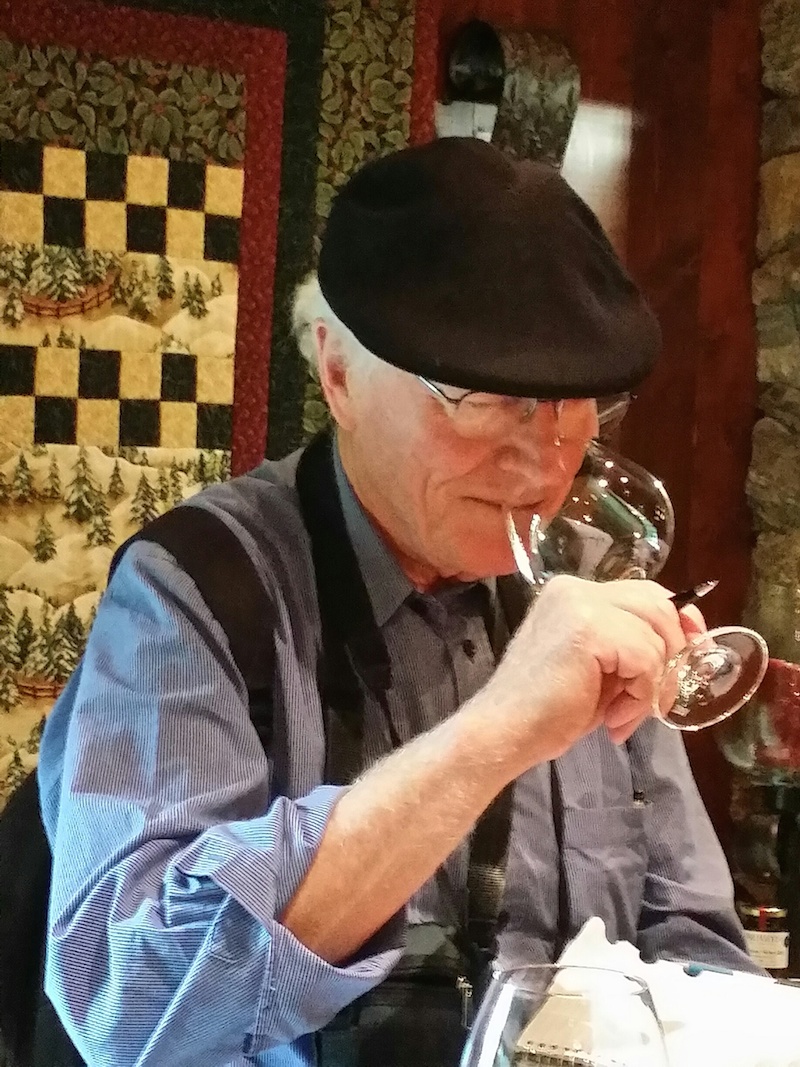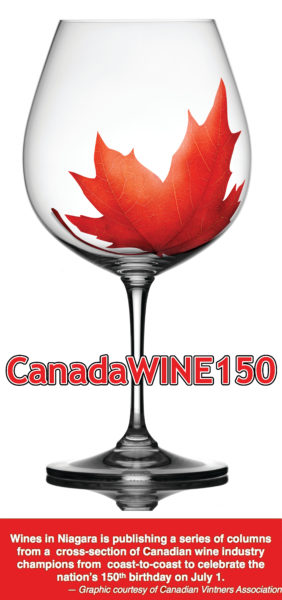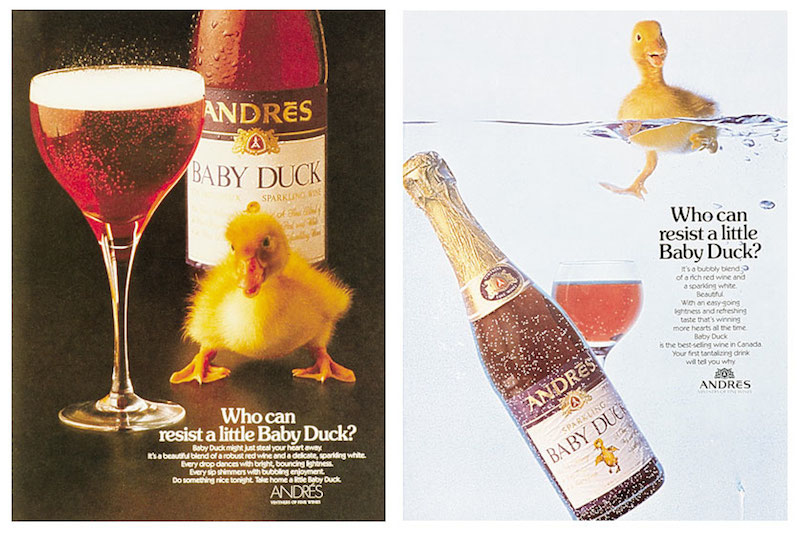
By John Schreiner
In 1983, Hugh Johnson was asked to look at a manuscript on the wines of Canada. Perhaps it was not surprising that he declined.
 In 2015, Steven Spurrier, another eminent British wine critic, visited Okanagan wineries and reviewed the wines positively in Decanter. He also presided at a tasting modelled on his famous 1976 Judgment of Paris tasting. The Judgment of B.C., as it was called, pitted six Chardonnay and six Syrah wines of B.C. against comparable wines from around the world. While the two best B.C. Chardonnays only ranked in the middle (the rest brought up the rear), the first place Syrah was a 2013 vintage from C.C. Jentsch Cellars, a winery that only opened in 2013.
In 2015, Steven Spurrier, another eminent British wine critic, visited Okanagan wineries and reviewed the wines positively in Decanter. He also presided at a tasting modelled on his famous 1976 Judgment of Paris tasting. The Judgment of B.C., as it was called, pitted six Chardonnay and six Syrah wines of B.C. against comparable wines from around the world. While the two best B.C. Chardonnays only ranked in the middle (the rest brought up the rear), the first place Syrah was a 2013 vintage from C.C. Jentsch Cellars, a winery that only opened in 2013.
Note: For full series so far on #CanadaWINE150 go here
That illustrates how much the profile of Canadian wines has risen, entirely because of their dramatically improved quality.
In the early 1980s, two of the best-selling Canadian wines were Baby Duck (made with Concord grapes) and Schloss Laderheim (made with a labrusca hybrid called Okanagan Riesling).
Andrés Wines Ltd., which crafted fizzy Baby Duck in 1971, was inspired by its Canadian success to export it to Britain in 1979. Despite a $2.5 million advertising campaign there, Baby Duck flopped. In its review, the London Sunday Times wrote: “The drink [is] purple, sparkling stuff [that] tastes like black currant wine gum dissolved in a glass of Andrews Liver Salt. Served extremely cold — preferably on a stick — you might be amused by its presumption.” Is it any wonder that Hugh Johnson refused to look at a book on the Canadian wines of that period?
Baby Duck and Schloss Laderheim (an off-dry German-styled white) were the best that could be done with the labrusca and hybrid grapes then growing in the Okanagan. In 1976, when Spurrier found Napa Cabernet Sauvignon wines to challenge and even best leading Bordeaux reds, there was no Cabernet or Merlot in the Okanagan. Those varieties would not be planted there for another 20 years.

The mediocre wines that turned off Johnson (and other critics) were the product of our ignorance. There were no schools of viticulture and winemaking in Canada to challenge the conventional wisdom that vinifera grapes would not survive here. The national wine palate was unsophisticated. Canadian wines succeeded largely because liquor stores applied discriminatory markups to imports — if they listed many at all.
That all changed in 1988 when the free trade agreement with the U.S. began dismantling preferential treatment of Canadian wine. In the Okanagan, two thirds of the vines were pulled out after the 1988 harvest, removing most of the hybrid varieties. The remaining 1,100 acres were vinifera, grown by those who believed that Canadian wine had a future. Replanting of vineyards began in 1993. Within 15 years, acreage under vine reached 10,000 acres, close to the maximum that can support vines.
 The industry turnaround started in 1990 when the B.C. Wine Institute adopted the VQA program, certifying wines made with vinifera. Consumers responded so well to vinifera wines that new entrants were attracted to the industry. There were 17 wineries in B.C. in 1990. Today, there are 275 grape wineries. Sales of VQA wine, which has a 17% market share, totalled $254.5 million in 2015. When the non-VQA wines are added, B.C. wineries have a commanding 52% market share in B.C. It is a remarkable success.
The industry turnaround started in 1990 when the B.C. Wine Institute adopted the VQA program, certifying wines made with vinifera. Consumers responded so well to vinifera wines that new entrants were attracted to the industry. There were 17 wineries in B.C. in 1990. Today, there are 275 grape wineries. Sales of VQA wine, which has a 17% market share, totalled $254.5 million in 2015. When the non-VQA wines are added, B.C. wineries have a commanding 52% market share in B.C. It is a remarkable success.
The success of the industry has accelerated since 2000 when there were just 60 wineries in B.C. These are the key reasons:
- There has been a dramatic improvement in the number of trained viticulturists in the Okanagan. Growers have the skills, or access to it, to grow vinifera successfully, having identified the unique qualities of the terroir. Most vineyards have had detailed soil analysis so that the correct varieties and rootstocks are matched with the earth. Computers control drip irrigation systems.
- The industry gets meaningful and valuable technical support from provincial and federal scientists. That is a far cry from the largely failed work between the 1950s and 1980s crossing hybrids to create newer but still mediocre wine grapes.
- There has been an even more dramatic increase in the number of well-trained and experienced winemakers. These include Canadians trained abroad or in our own good winemaking schools, which did not exist in the Baby Duck era. There are also many trained winemakers who have emigrated from outside the country, attracted by the potential of B.C. wines.
- The winery infrastructure is up to international standards. The Mission Hill winery had dirt floors in 1981 when Anthony von Mandl bought it. Today, its cellars are state of the art. In contrast to the Bourbon barrels and redwood vats of the 1960, cellars now have French and American barrels and fermenters, along with stainless steel, concrete eggs and even clay amphorae. Many fermentation cellars are computer controlled.
- The consumers, including the restaurants, in B.C. are remarkably loyal to their industry. Consequently, 80% of B.C. wine is drunk in B.C. Most wineries have very successful wine clubs.

The future of B.C. wine is strong, limited only by the available supply of wine. There are not many additional plantable acres. At the same time, consumers elsewhere have begun to compete for the wines once they taste them. The Canadian government recently hosted a dinner in Sweden at which Canadian wine was served. The King of Sweden was so impressed with a Merlot from Painted Rock Estate Winery that he asked where he could get it. Painted Rock proprietor John Skinner subsequently initiated talks with Sweden’s liquor monopoly.
We have come a long way from Baby Duck. And that is not to denigrate a brand which endures and which powered Andrew Peller Ltd., as Andrés is now called, into a powerful and well-regarded national wine producer.
About John Schreiner
Vancouver wine writer John Schreiner has just released his 17th wine book. Icon: Flagship Wines from British Columbia’s Best Wineries (Touchwood Editions, $40). A 332-page hardcover, the book profiles about 100 wineries, with tasting notes and specifications for current and many previous vintages of leading wines. The book celebrates collecting wine verticals.
Born in Saskatchewan in 1936, John began a career in journalism with the Regina Leader Post. In 1961, he joined The Financial Post, leading to a 40-year career as a business writer until he retired in 2001. He took over the newspaper’s Vancouver bureau in 1973 and reported widely from Western Canada and Asia.
In 1996 he won a Jack Webster Award for business, industry and economic writing.
He began writing wine columns in 1974. Currently, he has a wine column in West Coast Homes & Design. He is a prolific blogger here.
His first wine book, published in 1984, was The World of Canadian Wines, (Douglas & McIntyre).
Since 1994, three editions of The Wineries of British Columbia have been published. His other books include:
The British Columbia Wine Companion, a compendium of essays, history and biography, was published in 1996.
Chardonnay and Friends, about varietal wines in British Columbia, was published in 1998.
Icewine: The Complete Story, the first comprehensive international book on this dessert wine, was published in November 2001 and was judged “best book on wine history” in English that year in the World Gourmand cookbook and wine book competition.
CedarCreek Wine Journal was published early in 2003.
British Columbia Wine Country, of which more than 10,000 copies have been sold, was published in March 2003 by Whitecap. It won a World Gourmand award for photography, a gold medal in the 2004 Vancouver Magazine Awards, and two silver medals in the 2004 Cuisine Canada competition. A completely revised second edition, with information on 175 producers, was published in April, 2007.
The Wines of Canada was published in May, 2005, by Mitchell Beazley Publishers of London; an updated paperback edition was released in October 2006 by Whitecap. This book is a comprehensive discussion of all of Canada’s wine regions, with profiles of about 300 producers, including fruit wineries and meaderies.
His most popular book is John Schreiner’s Okanagan Wine Tour Guide. The first edition was published in 2006. The fifth edition, double the size of the first, was published in the summer of 2014. A companion volume, John Schreiner’s Coastal BC Wineries Tour Guide, was released in April, 2011.
In 2002, the Okanagan Wine Festivals Society presented John with its Founders Award, an award given annually since 1984 to recognize contributions to the British Columbia wine industry. In 2009, the Vancouver International Wine Festival gave him its Spirited Industry Professional Award. He is a past chair of the Festival’s selection committee. In 2014 he was inducted into the B.C. Restaurant Association Hall of Fame as a friend of the industry.
His writing has been honoured by both national and regional wine industry groups. In 2015 the Canadian Vintners Association gave him its Canadian Wine Industry Champion award. In 2016 the British Columbia Wine Institute gave him its Industry Recognition Award.





Comment here